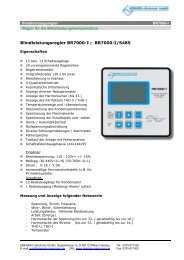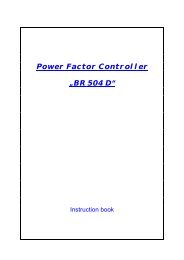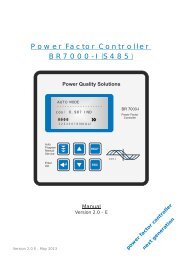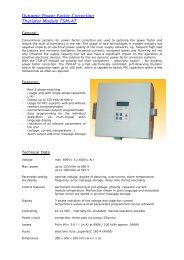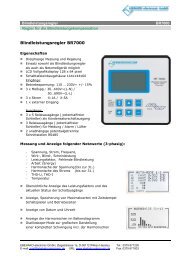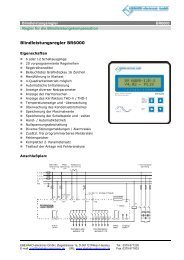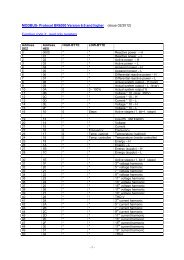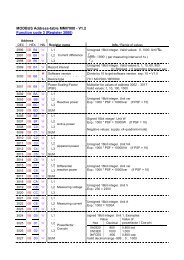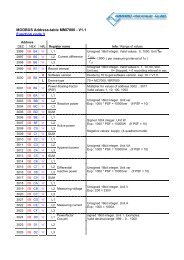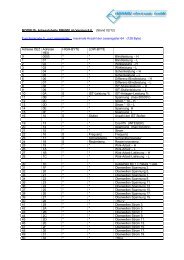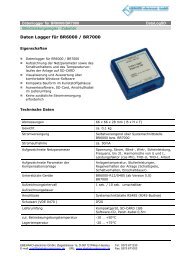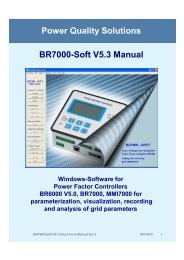TSM â LC10 Thyristor-Module for dynamic Power Factor Correction ...
TSM â LC10 Thyristor-Module for dynamic Power Factor Correction ...
TSM â LC10 Thyristor-Module for dynamic Power Factor Correction ...
You also want an ePaper? Increase the reach of your titles
YUMPU automatically turns print PDFs into web optimized ePapers that Google loves.
<strong>TSM</strong> – <strong>LC10</strong><br />
<strong>Thyristor</strong>-<strong>Module</strong> <strong>for</strong> <strong>dynamic</strong> <strong>Power</strong> <strong>Factor</strong> <strong>Correction</strong> (PFC)<br />
Description<br />
Version 1.0<br />
The <strong>TSM</strong>-<strong>LC10</strong> <strong>for</strong> Dynamic PFC is a fast electronically controlled self-observing thyristor<br />
switch <strong>for</strong> capacitive loads up to max. 12,5 kvar (400V) which is capable to switch PFC<br />
capacitors within a few milliseconds as often and as long as required without abrasion.<br />
Triggering can be done by means of <strong>dynamic</strong> power factor controllers, programmable logic<br />
controllers (PLC) or directly out of the technologic process.<br />
Features<br />
<br />
<br />
Component <strong>for</strong> the design of Dynamic<br />
PFC-systems in 400V-grids<br />
Micro-processor controlled alignment to<br />
tuned or de-tuned capacitor branches<br />
(up to 14%) <strong>for</strong> optimized switching<br />
behaviour.<br />
For capacitive loads up to 10 kvar at<br />
400V<br />
Monitoring of voltage and phase<br />
sequence; display of status via LED<br />
<br />
<br />
<br />
<br />
<br />
<br />
No system perturbation due to switching<br />
operations (transients)<br />
Switching without delay<br />
Maintenance free<br />
Long useful service life<br />
No noise emission during switching<br />
operation<br />
Compact module ready <strong>for</strong> connection<br />
Applications:<br />
Dynamic („real time“) PFC <strong>for</strong> fast processes, e.g.<br />
- pressing<br />
- welding machines<br />
- elevators<br />
- cranes<br />
- wind turbines etc.<br />
with fast changing and high fluctuating loads.<br />
Installation and connection<br />
The mechanical mounting is done directly on a mounting plate. The main terminals are designed<br />
as clamps and can be directly connected to the branch fuse resp. to the capacitor.<br />
Connection is done according picture 1. It is mandatory to use superfast electronic fuses as<br />
branch fuses of the <strong>TSM</strong>-module to protect the semiconductor device! Basics of dimensioning<br />
must be obeyed!<br />
Triggering of the module is taking place without any time delay by a 10 – 24 VDC signal (coming<br />
from the PFC-controller or an adequate control system) fed in at the connection X1 (signal).
Putting into operation<br />
After switching on the net voltage (engaging of the branch fuse) the thyristor module is<br />
ready <strong>for</strong> operation.<br />
For each phase the thyristor module has 2 status-LEDs with the following meaning:<br />
green:<br />
red is flashing:<br />
permanent red:<br />
LED “On” (yellow):<br />
operating voltage activated, thyristor module standby<br />
phase voltage L1-L3 too low (undervoltage
Pic 1:<br />
Connection diagramm: Three-phase load (standard)
Attention: Please follow SAFETY INSTRUCTIONS !<br />
GENERAL:<br />
<br />
<br />
<br />
<br />
<br />
<strong>Thyristor</strong>-modules may only be used <strong>for</strong> the purpose they have been designed <strong>for</strong>.<br />
<strong>Thyristor</strong>-modules may only be used in combination with appropriate safety devices (e.g.<br />
superfast fuses).<br />
<strong>Thyristor</strong>-modules have to be projected in such a way that in case of any failure no<br />
uncontrolled high current and voltages may occur.<br />
The devices have to be protected against moisture and dust – a sufficient cooling has to be<br />
assured.<br />
<strong>Thyristor</strong>-modules must only be switched to the net if any harm or danger to human beings or<br />
the PFC-system is eliminated.<br />
Attention<br />
Due to the switching principle of the thyristor module the power-capacitors are permanently<br />
loaded to the peak value of the grid voltage (DC voltage) even when switched off! There<strong>for</strong>e,<br />
following rules have to be obeyed in any case:<br />
<br />
<br />
<br />
<br />
<br />
<br />
For standard PFC-systems (without reactors) power capacitors of 440 V nominal voltage have<br />
to be used; <strong>for</strong> detuned systems PFC capacitors of 525 V nominal voltage have to be used.<br />
In <strong>dynamic</strong> PFC-systems with <strong>TSM</strong>-modules no fast discharge reactors may be used (reactor<br />
= DC-wise short circuit.)<br />
For tuned PFC-systems (without harmonic filter reactors) per thyristor module 2 current<br />
limitation reactors are mandatory! Available as accessory (BD100).<br />
<strong>Thyristor</strong>-modules in general have to be protected by superfast electronic fuses. Principles <strong>for</strong><br />
dimensioning have to be considered. Fuses in the system have to be marked!<br />
Due to the special switching, the PFC-capacitors are fully loaded even when the particular step<br />
has been switched off. Protection against contact has to be guaranteed. Warning signals in the<br />
system are required!<br />
Even in switched off state no electrical isolation is achieved <strong>for</strong> electronic switches. There<strong>for</strong>e<br />
parts of the systems may not be touched after switching off the complete system be<strong>for</strong>e the<br />
capacitors have been completely discharged.<br />
<br />
FAILURE TO FOLLOW CAUTIONS MAY RESULT, WORST CASE, IN PREMATURE FAILURES OR<br />
PHYSICAL INJURY.<br />
MAINTENANCE, REPAIR<br />
The thyristor-switch has to be deactivated <strong>for</strong> maintenance purpose and main circuit breaker must<br />
be released. It must be assured that it cannot be switched on during maintenance. It must be<br />
checked that there is no voltage at all. Maintenance must only be executed by specially skilled<br />
personnel.<br />
In case any repairs are needed, this must only be done from the manufacturers of the <strong>TSM</strong>thyristor-module!



